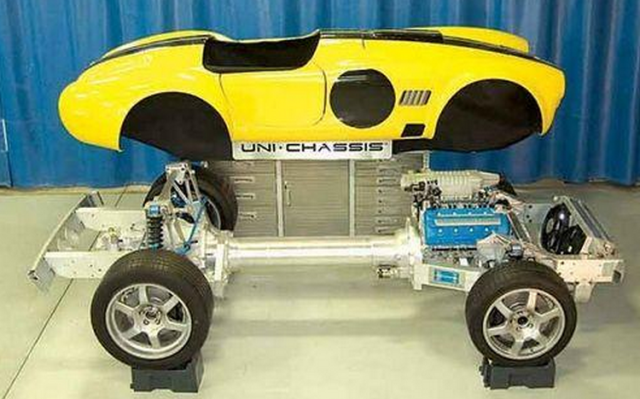The image below is of a chassis prototype. It consists of some aluminium sections and a few cast components with integrated suspension supports. Simple – light – cheap. It is fully engineered for supercar torsional and stiffness performance – and with crumple zones front and back. It is shown with a Shelby Cobra replica body and a V8 engine. The length can by changed by changing the length of the centre cylindrical section to take any body shape from classic sports and rally configurations to the utilitarian. Don’t put in an internal combustion engine, drive train and gearbox and you have saved considerable weight, cost and complexity.

Replace them with four Protean 75kW in hub electric motors with digital control of driving and braking in each wheel independently. Combine with a range extender and a couple of banks of batteries in metal casings either side of the central cylinder – and you have the makings of a very nice 300kW (400hp) vehicle. I have a 190kW Ford that drives pretty good – but this is a quantum leap in power to weight ratio.
Body materials can be conventional steel or aluminium, handmade carbon fibre or even fibreglass such as is used for beach buggies. What seems more 21st century is 3-d printed cars using ABS plastic and carbon fibres. At least potentially a body in any configuration can be printed out in micro-factories in a few hours. I am however doubtful that we can get the Shelby Cobra look – with its slick and shiny exhaust pipes trailing a V8 rumble down the sides – to work in an electric car. I’m thinking modern and muscular – with chunky tyres and good clearance. Something you could take on the Paris-Dakar. Not your stereotypical e-commute bubble car.

But what started me thinking down this track was Steampunk Girl’s post of a 1931 Bugatti Type 51 Dubos Coupe. That would work too. So poised – so elegant – so sexy. Both Steampunk Girl and the Bugatti.

Each in-wheel motor can be controlled entirely independently. So although there is a trade-off in unsprung weight (an extra 34kg per wheel) each wheel is independently controlled improving torque vectoring and control dynamics. With modern suspension tuning unsprung weight seems less of an issue compared to the drive advantages. These motors are increasingly being used for high end conversions. The low end torque and direct drive (no gearbox) mean spectacular traffic light drags.
A range extender is just a generator supplying electricity to the batteries. There are lots of different versions available but if you were planning an electric vehicle today the free piston linear generator would be hard to pass up. These are simply pistons that push magnets on a rod through a tube of coils. If you have ever seen those flashlights you shake up and down to charge – that’s the principle. They are very efficient, small, have very few moving parts, emit little noise or vibration and can provide sufficient power to push the vehicle along at highway speeds without further draining the batteries. I see it running on natural gas – because it’s green you know. Manufacturers all over the world are racing to bring these to the market.
The batteries installed now in electric cars use a lithium ion chemistry. Lithium batteries are expensive, have a low power density and limited range, are potentially unsafe and have environmental downsides. The need for a range extender presumes that lithium ion batteries will remain the most practical. A range extender allows for a reduction in the size, weight and cost of batteries.
The hope, however, is for a break though battery technology. The interesting figures are the energy density, the range and the cost. The power figure is a bit odd. First of all the units are in energy – and Tesla does have an 85kWh battery pack. But the range increase cited does still require 8 times more available energy – not a 15% increase. But the energy density claimed is indeed possible according to Cambridge University – which is the important thing. A 200kWh battery pack would weigh 100kg, cost $4000 to make and deliver a range of 500km. Not as good as claimed but it does depend quite a bit on assumptions. Recharge is ultrafast at 15 minutes and would cost about $40. As well as being the subject of intense research worldwide -there are graphene batteries going into production for major companies in Spain.

The rest is just off the shelf parts – steering, electric brakes, air-conditioning, switches, power management, seats, lighting, instruments – sourced from manufacturers as any car maker does today. It simplifies things enormously. So relatively few moving parts. It is more like a desktop computer than a conventional car. Parts are plug and play – including the motors – and the whole thing can be custom built in local micro-factories. Strong, safe, light, simple, cheap and with spectacular performance – an electrical vehicle in your future seems more likely than not.
